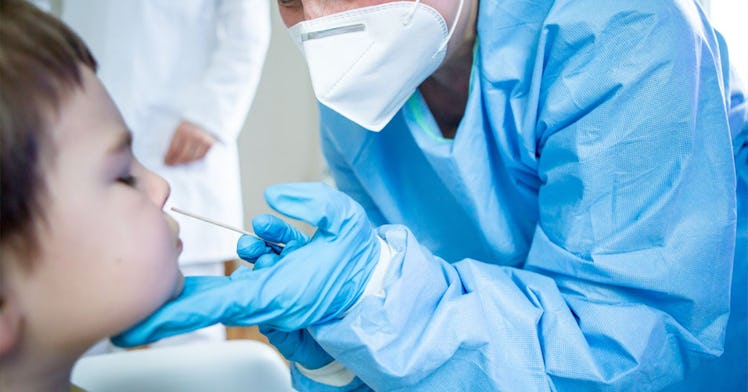‘Test and Stay’: What Parents Need to Know About the CDC’s New School Policy
On Friday December 17th, the CDC unveiled new testing guidance for unvaccinated students in schools. Here's what to know.

New guidance released last week by the Centers for Disease Control and Prevention (CDC) says that unvaccinated students who are exposed to COVID-19 can stay in school if they test negative. Exposed students will need to get COVID-19 tested twice in the week following their exposure, and both tests have to come back negative for the child to be able to stay in school. This means that students who are exposed to COVID-19 don’t need to be immediately quarantined or sent home from school.
This is a major change to school guidance. Previously, the CDC endorsed that unvaccinated kids who were exposed to COVID-19 had to quarantine at home for two weeks before being able to return to the physical classroom. The burden of quarantining at home fell squarely on the shoulders of working parents who had to figure out child care options and balance working from home with a potentially sick kid.
So what changed? Why did the CDC change course after resisting a ‘test-and-stay’ policy for so long? Here’s what to know about new research re: ‘test and stay,’ and what it means for you.
Why Did The CDC Choose a ‘Test-and-Stay’ Policy for Unvaccinated Students?
Two studies — one from California and the other from Illinois — investigated the ‘test-and-stay’ method in a county from each state, and their results were good news for parents who want their kids to maximize their hours in the classroom.
In the Los Angeles County study, students from 432 schools who were exposed to COVID-19 and were unvaccinated lost zero school days, and the schools themselves didn’t see an increase in virus rates using the test-and-stay method; in 1,635 schools in the area where students quarantined after COVID-19 exposure, they lost nearly 93,000 school days collectively in just over a month.
In Illinois, Lake County specifically, the results were similar. Unvaccinated students exposed to COVID-19 didn’t seem to transmit the virus to others, and more than 8,000 school days were saved by the test-and-stay program.
In the studies, per CDC director Dr. Rochelle Walensky, “masks were worn consistently and correctly. Close contacts of a positive case were monitored for symptoms and stayed home if they became ill.”
However, there is some concern about the research because it was done well before the rise of Omicron, the COVID-19 variant that has caused rates to skyrocket in the United States and now is the source of 73 percent of new cases of COVID-19 in the country. Omicron is highly transmissible, and though early research suggests it may be less likely to cause severe disease than previous variants of the coronavirus, the research is just that — early.
Of note, the test-and-stay guidance is for unvaccinated students only. Currently, students who are fully vaccinated “do not need to participate in screening testing and do not need to quarantine if they do not have any symptoms,” per the CDC.
What Does ‘Test-and-Stay’ Mean For Parents?
For parents of unvaccinated kids, such as those who are under five, who attend schools that adopt the test-and-stay policy, they will have to deal with fewer disruptions to their child’s education. And right now, that seems to be the best thing for kids, experts say.
“It’s clear that the best place for children is in-school learning, and if it can be done safely for a child who may have been exposed to COVID, then we need to do that,” Dr. Richard Besser, president of the Robert Wood Johnson Foundation, and a former acting CDC director, told NBC News.